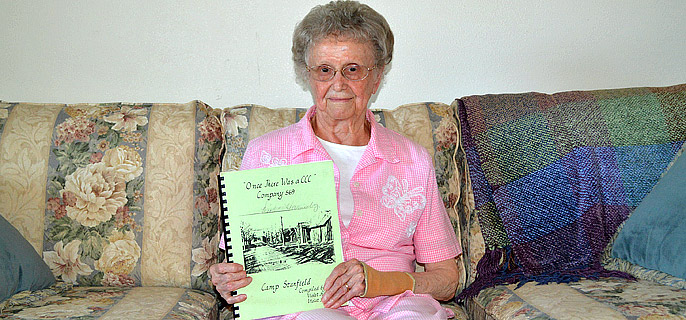
[quote style=”2″]Violet Able’s Book Chronicles the Story of the CCC in Stanfield[/quote]
The year was 1933 and the country was in the deepest depths of the Great Depression. The unemployment rate was 25 percent and all but the very fortunate were struggling to put food on the table.
For some perspective, the highest unemployment rate during the recent Great Recession was 10 percent in October 2009. Life in the United States in 1933 was grim and people were desperate. Franklin Roosevelt had just been elected president and in his first 100 days in office he passed 15 pieces of legislation, many aimed at putting Americans back to work. One of his initial programs was the Civilian Conservation Corps (CCC) or the 3Cs as some call it, a work relief program that ran from 1933-1942. To be eligible, enrollees had to be between the ages 18-25, unemployed, unmarried and come from families that were receiving government relief of some kind.
Work camps were established around the country in which the men would plant trees, build roads, dig canals and develop parks. At one time there were more than 2,900 CCC camps and total enrollment during the life of the program was 3 million.

“He was looked up to by all the men in the camp,” Violet said.
Joe Hornsby was from Kentucky and joined the CCC in 1934 to help support his family. Each man in the CCC was paid $30 a month – $25 of which had to be sent back home to the man’s family. Company 569 was first sent to Camp Horse Heaven in Coeur d’Alene, Idaho. By October 1935, the company had been transferred to Stanfield where they would remain for the next three years. During their time in Stanfield, the men opened up thousands of acres to farming. Joe served as a cook in Company 569.
After leaving the CCC, Joe went to work on the construction of the Umatilla Army Depot and continued working there until his retirement in 1973. It was at the depot where he met Violet, who had come to work at the depot after moving to Oregon from Missouri. During World War II, she got a teaching certificate at the young age of 18. The country had a shortage of teachers at the time and so the requirements to become a teacher were relaxed. After the war, however, she was going to have to go back to school to get her four-year degree if she wanted to continue teaching.

“We thought that was a lot of money then,” she said.
During the early years of their marriage, Joe introduced Violet to his friends from his old CCC days, many of whom had stayed in the area after leaving the program.
“One day, Joe and I and Jack Harpster (one of Joe’s CCC buddies) got together and we decided to have a reunion of Company 569,” Violet said. They first held their reunion in 1957 near McNary Dam and later moved the reunions to Hat Rock State Park, usually in June.
“They were like family,” Violet said. When Joe died of cancer in 1983, his fellow CCC buddies served as his pall bearers.
The reunions continued after Joe’s death and in 1986, thinking ahead to the following year’s reunion, Violet decided to write a history of Company 569.
“I wanted to give it to each of the men at the 30th reunion in 1987,” she said.

The reunions no longer take place. All of the men of Company 569 have since passed away. Only four of their wives are still alive: Violet, Margaret (Woody) Daniels, Leona (Jack) Harpster and Bonnie (Frank) Weitzel. Violet still keeps in touch with the remaining wives. In 1992, Violet married Boone Able, who passed away in 2003.
Today, there are few people left who remember that Stanfield was home to one of the New Deal’s greatest programs.
“Not a lot of people know about it,” Violet said. “It was so long ago.” But, she said, it was, perhaps, the most important years of those men’s lives.

The two Violets made only 25 copies of Once There Was A CCC. She has two copies and one is located at the Echo Museum. It was, she said, a labor of love because she came to cherish the men and their wives who were part of Company 569. The last lines of the book bear that out:
“I would like to join Violet Hill in expressing my pride and affection for you all. I thank God for allowing me to become part of your lives when I met and married my CCC boy thirty-five years ago. Please enjoy the book as much as I have enjoyed compiling it.”









